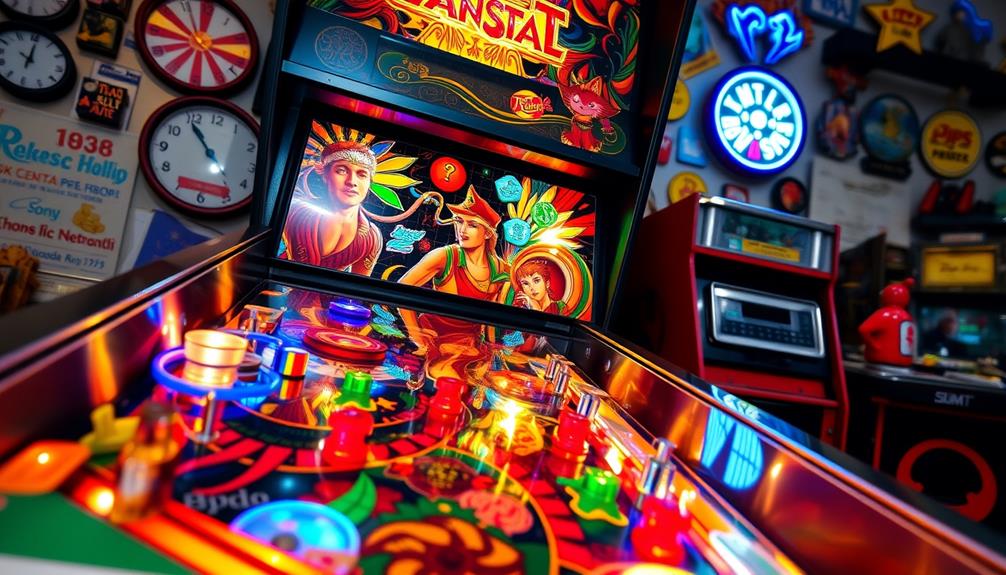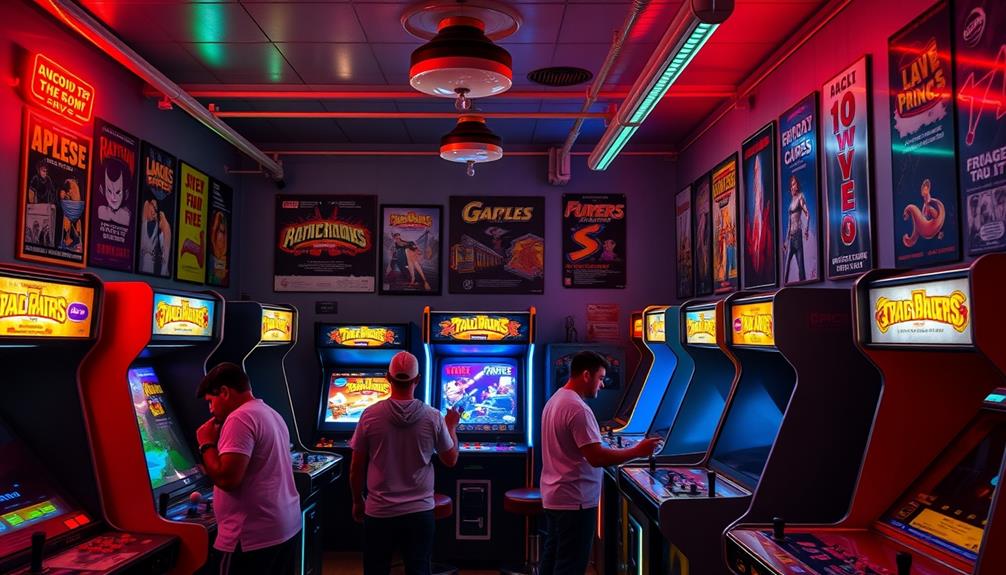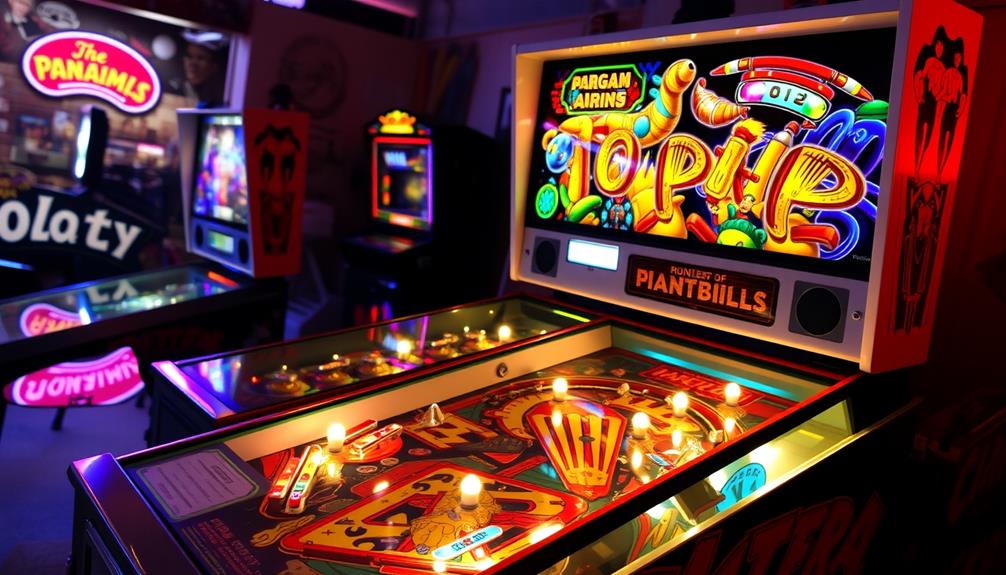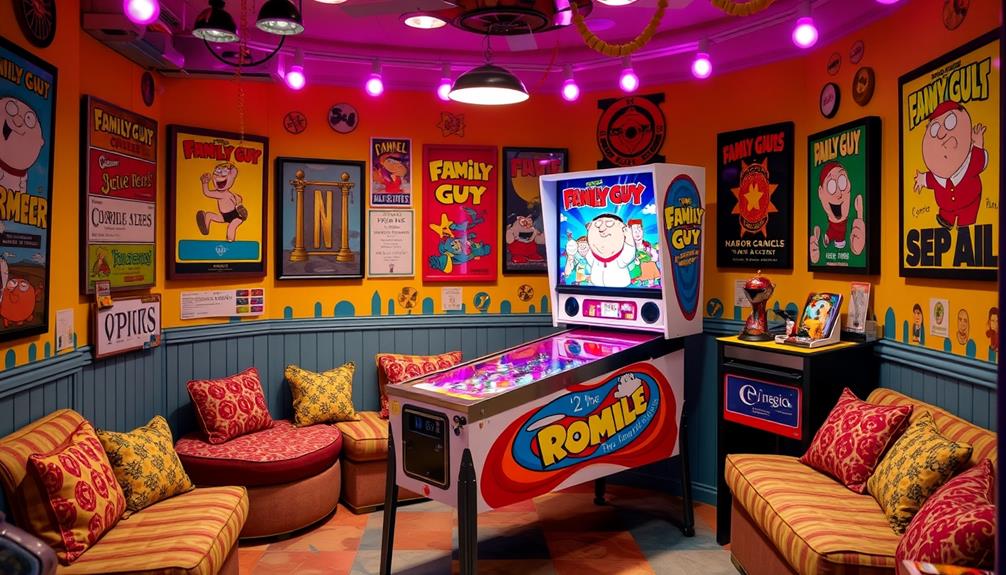Pinball has a fascinating past that dates back to the 18th century, originating from the French game **Bagatelle**. Over time, it underwent significant changes, including an improved version patented by Montague Redgrave in 1871. The first modern coin-operated **pinball** machine, **Ballyhoo**, made its debut in 1931, revolutionizing the gaming scene. With advancements like the **tilt mechanism** and flippers, gameplay shifted from luck to skill. If you’re curious about its captivating journey and cultural impact, there’s so much more to explore. The rich and diverse history of pinball involves legal battles, controversies, bans, and restrictions in various cities. Despite these challenges, pinball persisted and thrived, embracing electronic components in the 1970s and 80s, ushering in a new era of machines with digital displays and sound effects. This enduring popularity and ability to adapt to evolving technologies and cultural shifts make pinball a timeless classic that continues to captivate enthusiasts worldwide.
Key Takeaways
- Pinball originated from the 18th-century game Bagatelle in France, marking its early beginnings.
- The first modern coin-operated pinball machine, Ballyhoo, was developed in 1931.
- The term "pinball" gained popularity in 1936, indicating its established identity.
- The tilt mechanism was introduced in 1934, adding strategy to gameplay.
- The evolution of pinball continued with significant advancements throughout the 1930s and beyond.
Origins of Pinball
Pinball traces its roots back to the 18th century with the game Bagatelle, which gained popularity in France. Players would launch balls onto a sloped board, aiming to land them in various pockets for points. This laid the groundwork for what you'd come to know as pinball.
In 1871, Montague Redgrave patented an improved version of Bagatelle, introducing a coiled spring and plunger mechanism that set the stage for future innovations. Curiously, just as essential oils for relaxation can enhance your well-being, the engaging nature of pinball provided a form of entertainment that captivated players.
By the early 1930s, the first modern coin-operated pinball machines began to emerge. Notable examples like Bingo, Baffle Ball, and Ballyhoo captivated players, with Ballyhoo being recognized as the first coin-operated machine. The term "pinball" itself gained traction in 1936, marking a shift in how the game was perceived.
Harry Williams further transformed the gameplay experience in 1934 by introducing the tilt mechanism. This allowed players to physically engage with the machines, adding a layer of strategy and excitement.
As you explore the history of pinball machines, you'll see how these early developments paved the way for the dynamic and intricate games you enjoy today.
Early Coin-Operated Machines

In the early 1930s, you'd find the first coin-operated pinball machines, like "Bingo" and "Bally Hoo," capturing players' attention.
These machines set the stage for evolving gameplay mechanics, with luck being the primary factor in scoring. As players engaged with these early games, they also began to develop a sense of strategy, akin to budget planning in finance, to enhance their chances of winning.
As they gained popularity in arcades, they paved the way for pinball's lasting presence in the amusement industry.
First Coin-Operated Models
Among the early innovations in gaming, the first coin-operated pinball machines emerged in the early 1930s, revolutionizing entertainment. The first coin-operated pinball machine, Ballyhoo, was developed by Raymond T. Maloney in 1931, marking a significant milestone in the evolution of pinball.
Shortly after, Baffle Ball was introduced, quickly gaining popularity for its simple mechanical gameplay. This game featured an inclined playfield that enabled players to launch balls using springs and aim for various targets. The engaging nature of these machines can be likened to the charismatic traits of zodiac signs, which often draw people in and keep them coming back for more.
During the Great Depression, these machines provided affordable amusement. Baffle Ball sold for just $17.50 and dispensed multiple balls for a penny, making it accessible to many.
The term "pinball" itself wouldn't be officially coined until 1936, but the foundation of what we recognize as pinball was firmly established with these early models.
As you explored these early machines, you could see how they set the stage for the future of pinball. Their mechanical ingenuity and engaging gameplay captured the attention of players, paving the way for the vibrant arcade culture that would follow.
Evolution of Gameplay Mechanics
The evolution of gameplay mechanics in early coin-operated machines marked a significant shift in how players interacted with the game. The first pinball machine, "Baffle Ball," introduced in 1931, was purely mechanical, using a spring-loaded plunger to launch the ball. Scoring relied on bumpers and gates, making it a game of chance. However, things changed dramatically when the tilt mechanism was invented in 1934. This allowed you to influence the ball's movement while preventing excessive force that could lead to penalties.
In 1947, the introduction of flippers in Gottlieb's "Humpty Dumpty" revolutionized gameplay, transforming it from a game of chance to one of skill. As the 1930s progressed, electromechanical games began incorporating electrical components, enhancing the experience with sound effects and lights.
Here's a quick look at the evolution:
| Year | Innovation | Impact |
|---|---|---|
| 1931 | First Pinball Machine | Launched pinball as a commercial game |
| 1933 | Electrically Powered Machines | Enhanced gameplay with sound and lights |
| 1934 | Tilt Mechanism | Increased player control |
| 1947 | Introduction of Flippers | Shifted gameplay to skill-based |
| 1970s | Solid-State Electronic Machines | Revolutionized pinball technology |
Popularity in Arcades
During the 1930s, pinball machines quickly became a favorite attraction in bars and amusement arcades. The introduction of the Ballyhoo in 1931 marked the beginning of pinball's popularity as a coin-operated game. These early mechanical machines offered a straightforward yet exciting challenge, requiring players to launch steel balls with a spring-loaded plunger and score points by hitting various targets.
The appeal of such games can be likened to the way cold medications provide effective relief by engaging users with their straightforward mechanics and immediate gratification.
By the late 1930s, pinball had cemented its place in entertainment venues, thanks to the addition of bumpers in 1937. This innovation enhanced gameplay dynamics, making it even more engaging for players.
The Great Depression played a significant role in boosting pinball's popularity, as it provided a low-cost entertainment option in candy stores, pool halls, and arcades.
The game evolved further with the introduction of flippers in 1947, transforming pinball from a game of chance into one of skill. This key change attracted a broader audience, ensuring that pinball machines remained a staple in arcades for years to come.
As you explored these lively venues, you'd find that pinball wasn't just a game; it became a cultural phenomenon.
Technological Advancements

Revolutionizing the gaming experience, technological advancements have played a crucial role in the evolution of pinball machines. The journey began in 1933 with the first electrically powered pinball machine, utilizing sound effects from electromechanical bells and buzzers.
In 1937, Bally introduced coil bumpers, greatly enhancing gameplay dynamics and interaction. These innovations laid the groundwork for future developments, much like how top projectors enhance gaming experiences for modern players.
Fast forward to 1975, when game designers revealed the first solid-state electronic pinball, Micro's Spirit of 76. This machine brought a new level of sophistication to pinball technology.
Just a year later, Williams launched Flicker, the first pinball machine to incorporate a microprocessor, allowing for more complex gameplay mechanics and experiences.
Today, modern pinball machines are a reflection of advanced technology, featuring elements like animatronics and vibrant LCD screens that captivate players.
For instance, Stern Pinball's Jurassic Park showcases how far the game has come, blending nostalgia with cutting-edge features. These advancements not only enhance interactivity but also guarantee that pinball remains a compelling and engaging experience for all players.
The Rise of Flippers

The introduction of flippers in pinball machines revolutionized how you interact with the game. Instead of relying solely on chance, you could now skillfully control the ball's path, making each play more engaging.
This shift mirrors the principles of design thinking, which emphasizes user-centric solutions and creative problem-solving.
As flipper designs evolved, they drastically changed gameplay mechanics and strategies, leading to a new era in pinball history.
Evolution of Flipper Design
Flippers made their debut in the world of pinball in 1947 with Gottlieb's "Humpty Dumpty," marking a pivotal moment that altered gameplay from pure chance to skill-based mechanics.
Before flippers, pinball machines relied solely on gravity and player nudging, which limited your interaction and strategy. You could only watch the ball roll and hope for the best. This change was celebrated by players who sought a more engaging experience, similar to the themes of positivity and warmth found in songs like Blue Skies and Lemonade.
The design of flippers evolved quickly after their introduction. In 1950, Steve Kordek created "Triple Action," the first game to feature two outward-facing flippers, which greatly enhanced player control over the ball.
This innovation allowed you to execute more sophisticated maneuvers, altering how you approached scoring and gameplay.
Just a few months later, Gottlieb's "Just 21" introduced inward-facing flippers, refining the dynamics even further.
This evolution in flipper design fundamentally transformed the gaming experience, leading to more complex playfields and varied scoring opportunities.
As flippers became more popular, they opened up a world of strategy and skill that pinball enthusiasts still enjoy today.
Each advancement in flipper design contributed to an ever-evolving landscape of pinball machines, making the game more engaging than ever before.
Impact on Gameplay Mechanics
As players discovered the newfound control offered by flippers, pinball machines transformed from simple games of chance into intricate tests of skill. With the introduction of flippers in 1947, particularly in "Humpty Dumpty," gameplay dynamics shifted dramatically.
This evolution mirrored the innovations seen in coffee brewing methods, where techniques like the French press coffee revolutionized how enthusiasts experienced their favorite beverage. You weren't just hoping for a lucky bounce anymore; you needed to engage in skillful play and precision aiming.
This evolution paved the way for several significant changes in the pinball landscape:
- Increased Focus on Skill: Players began honing their abilities, leading to a more strategic approach to the game.
- Rise of Competitive Play: Flippers allowed for more exciting gameplay, contributing to the formation of tournaments and leagues.
- Diverse Gameplay Mechanics: Innovations, like Gottlieb's inward-facing flippers in "Just 21," further enhanced player control and engagement.
The impact of flippers on pinball was profound, as it turned pinball into a competitive game where players could showcase their talents.
The thrill of competition, along with the demand for precision, has made pinball a beloved pastime that continues to evolve today.
Cultural Impact and Bans

Many people don't realize that pinball machines were once banned in several major U.S. cities from the 1940s to the 1970s. These bans stemmed from concerns over gambling and the perception of pinball as a game of chance rather than a game of skill. Authorities feared that pinball machines could lead to gambling addiction, particularly among youth, and they often associated them with organized crime.
The legal landscape surrounding gaming has evolved considerably since then, much like the complexities involved in steering a divorce process, which can also be influenced by societal perceptions and legislation.
However, in 1976, New York City lifted its ban after legal battles proved pinball's status as a game of skill. This shift marked the beginning of a resurgence in pinball's popularity, reinforcing its cultural importance in American gaming.
By the late 20th century, pinball machines had become iconic fixtures in arcades, films, and television shows, solidifying their place in retro gaming history.
As interest in classic games grew, collectors began to seek out both vintage and modern pinball machines, celebrating their unique artistry and gameplay.
Today, pinball stands as a symbol of resilience and reinvention, reminding us of its enduring charm and impact on gaming culture.
Pinball's Revival and Future

Since the early 2000s, pinball has seen a remarkable revival, drawing in a new generation of players who cherish its hands-on, mechanical gameplay that stands apart from the digital gaming landscape. This resurgence is fueled by several key factors, including a growing interest in astrology and attractiveness that parallels the nostalgic charm of classic gaming.
- Advanced technology: Modern machines feature LED lighting and LCD monitors, enhancing the visual appeal and gameplay experience.
- Competitions: The rise of tournaments and events has fostered community engagement, creating a dedicated following of pinball enthusiasts.
- Independent manufacturers: Companies like Jersey Jack Pinball and Spooky Pinball are revitalizing the market with innovative designs and themes.
The nostalgic charm of classic gaming plays a significant role in pinball's cultural significance. As you explore pinball museums and exhibitions, you'll find a proof of its enduring legacy.
The blend of traditional mechanics with cutting-edge technology guarantees that pinball remains relevant, attracting not just seasoned players but also newcomers keen to experience this unique pastime.
With continued innovation and a vibrant community, the future of pinball looks bright, promising new adventures for both old fans and new players alike.
Frequently Asked Questions
What Year Was Pinball Illegal?
Pinball was illegal in many U.S. cities from the 1940s until the 1970s due to concerns over gambling. You'd find machines confiscated, and operators facing fines as society debated its classification as a game of skill.
When Was Pinball Most Popular?
Pinball's most popular days sparkled brightly in the 1990s, when machines like "The Addams Family" enchanted players. You'd find crowded arcades, laughter echoing, as flippers danced and balls flew, creating unforgettable gaming moments.
Why Was Pinball Banned in New York?
Pinball was banned in New York due to fears it promoted gambling and addiction. City officials worried about its influence on children, leading to public outcry and legal restrictions that lasted over three decades.
What Is the Old Game of Pinball Called?
You'll find that the old game of pinball, called Bagatelle, involves skill and strategy. Just like pinball, it challenges players to score while maneuvering around obstacles, showcasing the timeless appeal of precision and enjoyment.
Conclusion
To summarize, pinball's journey from humble beginnings to a beloved pastime has been nothing short of magical. While it faced some bumps along the way, its charm and excitement have always managed to shine through. As you step up to the machine, you're not just playing a game; you're joining a vibrant community that's kept the spirit alive. So, let the silver balls roll, and embrace the nostalgia and thrill that pinball continues to offer!









